Han Zou
Sid
SpecServe: Efficient and SLO-Aware Large Language Model Serving with Adaptive Speculative Decoding
Mar 07, 2025Abstract:Large Language Model (LLM) services often face challenges in achieving low inference latency and meeting Service Level Objectives (SLOs) under dynamic request patterns. Speculative decoding, which exploits lightweight models for drafting and LLMs for verification, has emerged as a compelling technique to accelerate LLM inference. However, existing speculative decoding solutions often fail to adapt to varying workloads and system environments, resulting in performance variability and SLO violations. In this paper, we introduce SpecServe, an efficient LLM inference system that dynamically adjusts speculative strategies according to real-time request loads and system configurations. SpecServe proposes a theoretical model to understand and predict the efficiency of speculative decoding across diverse scenarios. Additionally, it implements intelligent drafting and verification algorithms to guarantee optimal performance while achieving high SLO attainment. Experimental results on real-world LLM traces demonstrate that SpecServe consistently meets SLOs and achieves substantial performance improvements, yielding 1.14$\times$-14.3$\times$ speedups over state-of-the-art speculative inference systems.
SerialGen: Personalized Image Generation by First Standardization Then Personalization
Dec 02, 2024

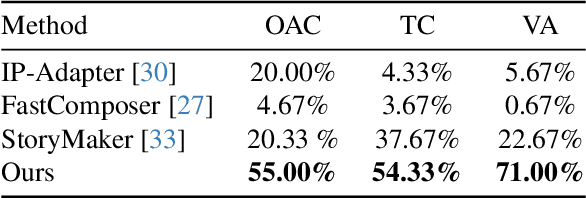

Abstract:In this work, we are interested in achieving both high text controllability and overall appearance consistency in the generation of personalized human characters. We propose a novel framework, named SerialGen, which is a serial generation method consisting of two stages: first, a standardization stage that standardizes reference images, and then a personalized generation stage based on the standardized reference. Furthermore, we introduce two modules aimed at enhancing the standardization process. Our experimental results validate the proposed framework's ability to produce personalized images that faithfully recover the reference image's overall appearance while accurately responding to a wide range of text prompts. Through thorough analysis, we highlight the critical contribution of the proposed serial generation method and standardization model, evidencing enhancements in appearance consistency between reference and output images and across serial outputs generated from diverse text prompts. The term "Serial" in this work carries a double meaning: it refers to the two-stage method and also underlines our ability to generate serial images with consistent appearance throughout.
RecurFormer: Not All Transformer Heads Need Self-Attention
Oct 10, 2024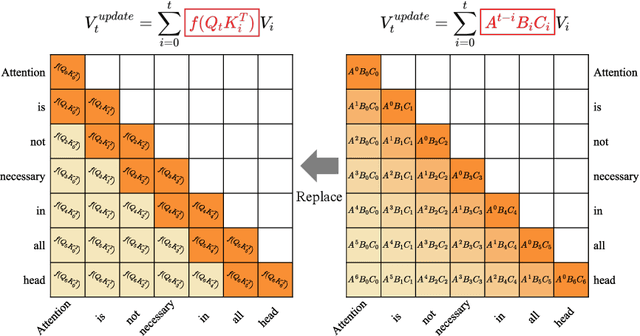

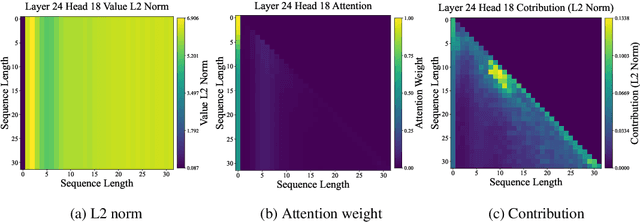
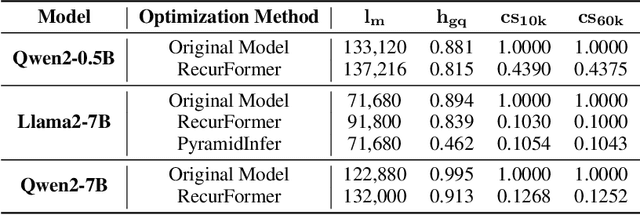
Abstract:Transformer-based large language models (LLMs) excel in modeling complex language patterns but face significant computational costs during inference, especially with long inputs due to the attention mechanism's memory overhead. We observe that certain attention heads exhibit a distribution where the attention weights concentrate on tokens near the query token, termed as recency aware, which focuses on local and short-range dependencies. Leveraging this insight, we propose RecurFormer, a novel architecture that replaces these attention heads with linear recurrent neural networks (RNNs), specifically the Mamba architecture. This replacement reduces the cache size without evicting tokens, thus maintaining generation quality. RecurFormer retains the ability to model long-range dependencies through the remaining attention heads and allows for reusing pre-trained Transformer-based LLMs weights with continual training. Experiments demonstrate that RecurFormer matches the original model's performance while significantly enhancing inference efficiency. Our approach provides a practical solution to the computational challenges of Transformer-based LLMs inference, making it highly attractive for tasks involving long inputs.
IoT-LLM: Enhancing Real-World IoT Task Reasoning with Large Language Models
Oct 03, 2024



Abstract:Large Language Models (LLMs) have demonstrated remarkable capabilities across textual and visual domains but often generate outputs that violate physical laws, revealing a gap in their understanding of the physical world. Inspired by human cognition, where perception is fundamental to reasoning, we explore augmenting LLMs with enhanced perception abilities using Internet of Things (IoT) sensor data and pertinent knowledge for IoT task reasoning in the physical world. In this work, we systematically study LLMs capability to address real-world IoT tasks by augmenting their perception and knowledge base, and then propose a unified framework, IoT-LLM, to enhance such capability. In IoT-LLM, we customize three steps for LLMs: preprocessing IoT data into formats amenable to LLMs, activating their commonsense knowledge through chain-of-thought prompting and specialized role definitions, and expanding their understanding via IoT-oriented retrieval-augmented generation based on in-context learning. To evaluate the performance, We design a new benchmark with five real-world IoT tasks with different data types and reasoning difficulties and provide the benchmarking results on six open-source and close-source LLMs. Experimental results demonstrate the limitations of existing LLMs with naive textual inputs that cannot perform these tasks effectively. We show that IoT-LLM significantly enhances the performance of IoT tasks reasoning of LLM, such as GPT-4, achieving an average improvement of 65% across various tasks against previous methods. The results also showcase LLMs ability to comprehend IoT data and the physical law behind data by providing a reasoning process. Limitations of our work are claimed to inspire future research in this new era.
The Llama 3 Herd of Models
Jul 31, 2024Abstract:Modern artificial intelligence (AI) systems are powered by foundation models. This paper presents a new set of foundation models, called Llama 3. It is a herd of language models that natively support multilinguality, coding, reasoning, and tool usage. Our largest model is a dense Transformer with 405B parameters and a context window of up to 128K tokens. This paper presents an extensive empirical evaluation of Llama 3. We find that Llama 3 delivers comparable quality to leading language models such as GPT-4 on a plethora of tasks. We publicly release Llama 3, including pre-trained and post-trained versions of the 405B parameter language model and our Llama Guard 3 model for input and output safety. The paper also presents the results of experiments in which we integrate image, video, and speech capabilities into Llama 3 via a compositional approach. We observe this approach performs competitively with the state-of-the-art on image, video, and speech recognition tasks. The resulting models are not yet being broadly released as they are still under development.
TENT: Connect Language Models with IoT Sensors for Zero-Shot Activity Recognition
Nov 14, 2023Abstract:Recent achievements in language models have showcased their extraordinary capabilities in bridging visual information with semantic language understanding. This leads us to a novel question: can language models connect textual semantics with IoT sensory signals to perform recognition tasks, e.g., Human Activity Recognition (HAR)? If so, an intelligent HAR system with human-like cognition can be built, capable of adapting to new environments and unseen categories. This paper explores its feasibility with an innovative approach, IoT-sEnsors-language alignmEnt pre-Training (TENT), which jointly aligns textual embeddings with IoT sensor signals, including camera video, LiDAR, and mmWave. Through the IoT-language contrastive learning, we derive a unified semantic feature space that aligns multi-modal features with language embeddings, so that the IoT data corresponds to specific words that describe the IoT data. To enhance the connection between textual categories and their IoT data, we propose supplementary descriptions and learnable prompts that bring more semantic information into the joint feature space. TENT can not only recognize actions that have been seen but also ``guess'' the unseen action by the closest textual words from the feature space. We demonstrate TENT achieves state-of-the-art performance on zero-shot HAR tasks using different modalities, improving the best vision-language models by over 12%.
Reference-based Motion Blur Removal: Learning to Utilize Sharpness in the Reference Image
Jul 06, 2023



Abstract:Despite the recent advancement in the study of removing motion blur in an image, it is still hard to deal with strong blurs. While there are limits in removing blurs from a single image, it has more potential to use multiple images, e.g., using an additional image as a reference to deblur a blurry image. A typical setting is deburring an image using a nearby sharp image(s) in a video sequence, as in the studies of video deblurring. This paper proposes a better method to use the information present in a reference image. The method does not need a strong assumption on the reference image. We can utilize an alternative shot of the identical scene, just like in video deblurring, or we can even employ a distinct image from another scene. Our method first matches local patches of the target and reference images and then fuses their features to estimate a sharp image. We employ a patch-based feature matching strategy to solve the difficult problem of matching the blurry image with the sharp reference. Our method can be integrated into pre-existing networks designed for single image deblurring. The experimental results show the effectiveness of the proposed method.
RefVSR++: Exploiting Reference Inputs for Reference-based Video Super-resolution
Jul 06, 2023



Abstract:Smartphones equipped with a multi-camera system comprising multiple cameras with different field-of-view (FoVs) are becoming more prevalent. These camera configurations are compatible with reference-based SR and video SR, which can be executed simultaneously while recording video on the device. Thus, combining these two SR methods can improve image quality. Recently, Lee et al. have presented such a method, RefVSR. In this paper, we consider how to optimally utilize the observations obtained, including input low-resolution (LR) video and reference (Ref) video. RefVSR extends conventional video SR quite simply, aggregating the LR and Ref inputs over time in a single bidirectional stream. However, considering the content difference between LR and Ref images due to their FoVs, we can derive the maximum information from the two image sequences by aggregating them independently in the temporal direction. Then, we propose an improved method, RefVSR++, which can aggregate two features in parallel in the temporal direction, one for aggregating the fused LR and Ref inputs and the other for Ref inputs over time. Furthermore, we equip RefVSR++ with enhanced mechanisms to align image features over time, which is the key to the success of video SR. We experimentally show that RefVSR++ outperforms RefVSR by over 1dB in PSNR, achieving the new state-of-the-art.
MM-Fi: Multi-Modal Non-Intrusive 4D Human Dataset for Versatile Wireless Sensing
May 12, 2023Abstract:4D human perception plays an essential role in a myriad of applications, such as home automation and metaverse avatar simulation. However, existing solutions which mainly rely on cameras and wearable devices are either privacy intrusive or inconvenient to use. To address these issues, wireless sensing has emerged as a promising alternative, leveraging LiDAR, mmWave radar, and WiFi signals for device-free human sensing. In this paper, we propose MM-Fi, the first multi-modal non-intrusive 4D human dataset with 27 daily or rehabilitation action categories, to bridge the gap between wireless sensing and high-level human perception tasks. MM-Fi consists of over 320k synchronized frames of five modalities from 40 human subjects. Various annotations are provided to support potential sensing tasks, e.g., human pose estimation and action recognition. Extensive experiments have been conducted to compare the sensing capacity of each or several modalities in terms of multiple tasks. We envision that MM-Fi can contribute to wireless sensing research with respect to action recognition, human pose estimation, multi-modal learning, cross-modal supervision, and interdisciplinary healthcare research.
GaitFi: Robust Device-Free Human Identification via WiFi and Vision Multimodal Learning
Aug 30, 2022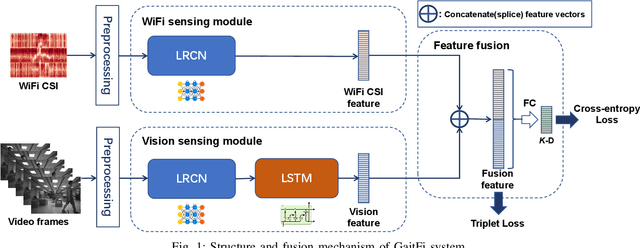

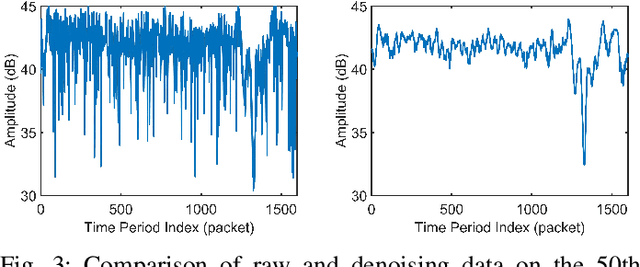
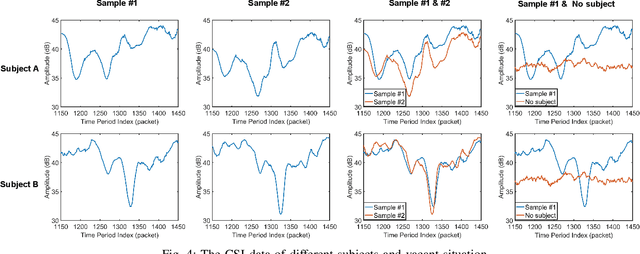
Abstract:As an important biomarker for human identification, human gait can be collected at a distance by passive sensors without subject cooperation, which plays an essential role in crime prevention, security detection and other human identification applications. At present, most research works are based on cameras and computer vision techniques to perform gait recognition. However, vision-based methods are not reliable when confronting poor illuminations, leading to degrading performances. In this paper, we propose a novel multimodal gait recognition method, namely GaitFi, which leverages WiFi signals and videos for human identification. In GaitFi, Channel State Information (CSI) that reflects the multi-path propagation of WiFi is collected to capture human gaits, while videos are captured by cameras. To learn robust gait information, we propose a Lightweight Residual Convolution Network (LRCN) as the backbone network, and further propose the two-stream GaitFi by integrating WiFi and vision features for the gait retrieval task. The GaitFi is trained by the triplet loss and classification loss on different levels of features. Extensive experiments are conducted in the real world, which demonstrates that the GaitFi outperforms state-of-the-art gait recognition methods based on single WiFi or camera, achieving 94.2% for human identification tasks of 12 subjects.
 Add to Chrome
Add to Chrome Add to Firefox
Add to Firefox Add to Edge
Add to Edge